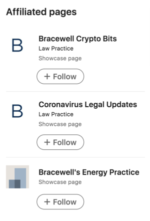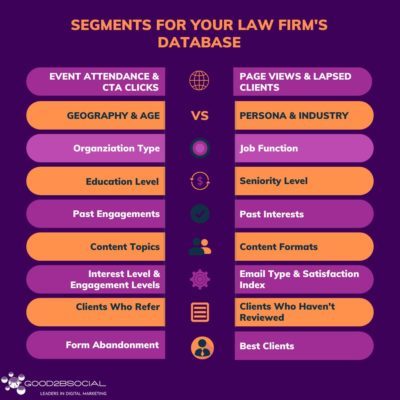
How to Market a Law Firm With Market Segmentation
An important part of how to market a law firm is targeting the correct audience. To do this, you first need to ensure you know who your
In our annual study of America’s top 200 law firms’ usage of social media and digital channels, The Social Law Firm Index, we discovered that market segmentation is a growing trend in legal marketing.
How to Market a Law Firm
Defining your target audience will help you be smart and strategic in your marketing tactics, increasing your ROI and allowing you to get the most of your marketing and business development efforts. If you haven’t gone through the exercise of identifying and segmenting your target audience, we have a few insights to help.
Ways to Segment Your Audience
Geographic Segmentation
This is probably the simplest way to target, and the most effective for several types of law firms. For those firms specializing in real estate or wills and estates, building awareness within a certain geographic area can be extremely beneficial. Name recognition can go a long way if you’re able to become widely known within your area. Try targeting by state, city, and county, but don’t ignore other segments that can be more precise. Look at school districts, voting districts, or areas where people work.
Demographic Segmentation
Demographics are those characteristics that are unique to an individual. Things like age, gender, income, family size, occupation, or religion can be helpful for narrowing down your audience. These features can be especially beneficial for lawyers who specialize in practices like discrimination, class action suits, or criminal cases.
Behavioral Segmentation
Behavioral segmentation can be particularly interesting to lawyers who work in the areas of products liability and matrimonial law. Examples of behavior factors include marital status (like married, divorced) and product usage (example: talcum powder).
Firmographic Segmentation
If you’re a corporate law firm, then firmographic segmentation can be a great option. This is a method of sorting clients by qualities such as company size or industry. Consider the following: one client is a 100-employee company that’s looking to solve an issue in employment law, while another company is a 10,000-employee, multinational company that’s looking for help with intellectual property law. Should these two clients be receiving the same emails or be approached with the same marketing tactics? Probably not. Market segmentation allows law firms serving diverse client types to implement more precise marketing campaigns, which ultimately increases engagement and client conversion.
Need-Based Segmentation
In a similar vein, need-based segmentation allows law firms to know which resources they should provide to specific clients. Clients looking for help within different practice areas are most likely going to find different types of content useful. Need-based segmentation can help you provide the right content to the right clients. The smaller company looking for help with employment law may find a blog post on workplace arbitration agreements helpful, while the large company may want a more in-depth webinar on the differences between patents, trademarks, and copyrights. Market segmentation for law firms can help inform content strategy.
Client Tiering
Client tiering is a means of segmenting your clients based on how well they match your business goals. In this form, you take a look at the importance of each prospect and client and rank them in terms of value or ROI. Using this information, marketers can decide which clients to focus on based on which would potentially bring in the most revenue. Perhaps it’s not worth the time or effort to pursue a case for a small company with a small case. It all depends on your law firm’s goals and experience.
Market Segmentation Application
After segmenting your audience, you may wonder what tactics you should be using to cater to these different audiences. Here are some ideas:
Blogs
The truth of the matter is every single blog you write is not going to resonate with every audience. Consider creating separate blog subpages that cater to the different topics relevant to each segment.
Resource Centers
As you create different content such as blogs, webinars, videos, or eBooks, consider organizing them by market segment into easy to use resource centers on your website. This makes navigation easy for your audience and ensures your users won’t see irrelevant information that could deter them from seeking a relationship with your firm.
One of the most common ways to cater to different market segments is to create different email campaigns or newsletters for each audience. Consider creating a newsletter for your larger segments, populating it with information and updates most pertinent to that
Social Media Pages
It’s become very common for firms to have multiple social media accounts on one platform; for example, one for careers or one for each practice area. Some platforms even cater to this type of segmentation, such as LinkedIn’s affiliate page feature.
Takeaway
You can begin defining a target market based on one of these segments, or a combination of all of them. Regardless of how you develop your target market, finding that specific audience and getting to know them is the first step in the success of your marketing plans. Once you segment your prospects and clients, you can even begin developing successful email marketing campaigns that are personalized to your contacts’ needs .If you need some assistance, reach out to us – we’re here to help!
This post has been edited and republished from Sep. 21, 2018.
Are you ready to get started generating new, qualified leads?
Contact us to get started and let us help you energize your digital marketing and business development efforts.
Contact Us


